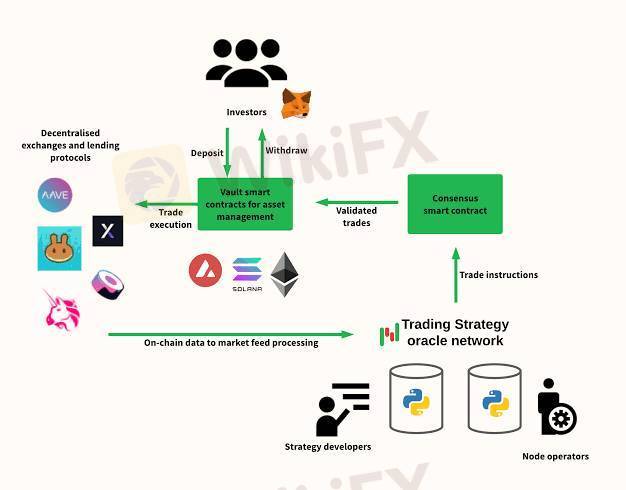
2025-02-06 15:17
SettoreSmart contract trading strategies
#firstdealofthenewyearFateema
Smart contract trading strategies involve using automated, self-executing contracts to execute trades based on predefined conditions. These strategies are widely used in decentralized finance (DeFi) for market-making, arbitrage, liquidation, and automated portfolio management. Here are some key strategies:
1. Arbitrage Trading
Cross-DEX Arbitrage: Identifying price discrepancies between decentralized exchanges (DEXs) like Uniswap, Sushiswap, or STON.fi to buy low and sell high.
Triangular Arbitrage: Exploiting price differences within a single DEX by trading through three different assets in a loop.
Flash Loan Arbitrage: Borrowing funds without collateral using flash loans to perform arbitrage trades and repaying in the same transaction.
2. Market-Making & Liquidity Provision
Automated Market Maker (AMM) Strategies: Providing liquidity on platforms like Uniswap v3, Balancer, or Curve while using concentrated liquidity strategies for optimal returns.
Rebalancing Liquidity Positions: Adjusting liquidity positions dynamically based on market conditions to minimize impermanent loss.
3. Trend-Following Strategies
Moving Average Crossovers: Using smart contracts to track exponential moving averages (EMA) and execute buy/sell orders when trends shift.
Momentum Trading: Executing trades when an asset’s price or volume exceeds predefined thresholds.
4. Mean Reversion Trading
Bollinger Bands Strategy: Buying when an asset’s price is below the lower band and selling when it is above the upper band.
RSI-Based Trading: Buying when the RSI is oversold (<30) and selling when it is overbought (>70).
5. Automated Yield Farming & Staking
Yield Optimization: Using smart contracts to move assets between DeFi protocols like Aave, Compound, or Yearn to maximize APY.
Auto-Compounding: Automating reinvestment of rewards to maximize returns over time.
6. Liquidation Bots
Lending Protocol Liquidation: Monitoring platforms like Aave or MakerDAO to liquidate undercollateralized positions and earn a liquidation bonus.
7. Sandwich Attacks & MEV Strategies
Front-Running Arbitrage: Placing a buy order before a large trade and selling immediately after to profit from slippage.
Back-Running: Detecting profitable transactions in the mempool and submitting orders right after to benefit.
Would you like to explore a specific strategy or discuss implementing a trading bot using smart contracts?
Mi piace 0
mmaette100
Trader
Discussione popolari
Settore
Offerta di lavoro Marketing
Settore
Marketing App
categoria forum

Piattaforma

Esibizione

IB

Reclutamento

EA

Settore

Mercato

indice
Smart contract trading strategies
 Nigeria | 2025-02-06 15:17
Nigeria | 2025-02-06 15:17#firstdealofthenewyearFateema
Smart contract trading strategies involve using automated, self-executing contracts to execute trades based on predefined conditions. These strategies are widely used in decentralized finance (DeFi) for market-making, arbitrage, liquidation, and automated portfolio management. Here are some key strategies:
1. Arbitrage Trading
Cross-DEX Arbitrage: Identifying price discrepancies between decentralized exchanges (DEXs) like Uniswap, Sushiswap, or STON.fi to buy low and sell high.
Triangular Arbitrage: Exploiting price differences within a single DEX by trading through three different assets in a loop.
Flash Loan Arbitrage: Borrowing funds without collateral using flash loans to perform arbitrage trades and repaying in the same transaction.
2. Market-Making & Liquidity Provision
Automated Market Maker (AMM) Strategies: Providing liquidity on platforms like Uniswap v3, Balancer, or Curve while using concentrated liquidity strategies for optimal returns.
Rebalancing Liquidity Positions: Adjusting liquidity positions dynamically based on market conditions to minimize impermanent loss.
3. Trend-Following Strategies
Moving Average Crossovers: Using smart contracts to track exponential moving averages (EMA) and execute buy/sell orders when trends shift.
Momentum Trading: Executing trades when an asset’s price or volume exceeds predefined thresholds.
4. Mean Reversion Trading
Bollinger Bands Strategy: Buying when an asset’s price is below the lower band and selling when it is above the upper band.
RSI-Based Trading: Buying when the RSI is oversold (<30) and selling when it is overbought (>70).
5. Automated Yield Farming & Staking
Yield Optimization: Using smart contracts to move assets between DeFi protocols like Aave, Compound, or Yearn to maximize APY.
Auto-Compounding: Automating reinvestment of rewards to maximize returns over time.
6. Liquidation Bots
Lending Protocol Liquidation: Monitoring platforms like Aave or MakerDAO to liquidate undercollateralized positions and earn a liquidation bonus.
7. Sandwich Attacks & MEV Strategies
Front-Running Arbitrage: Placing a buy order before a large trade and selling immediately after to profit from slippage.
Back-Running: Detecting profitable transactions in the mempool and submitting orders right after to benefit.
Would you like to explore a specific strategy or discuss implementing a trading bot using smart contracts?
Mi piace 0
Voglio commentare
Fai una domanda
0Commenti

Non ci sono ancora commenti. Crea uno.

Fai una domanda
Non ci sono ancora commenti. Crea uno.